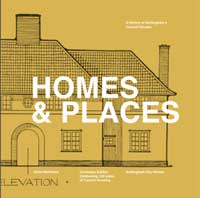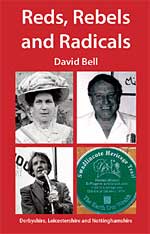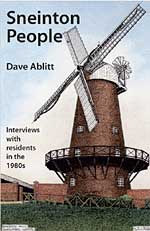Book reviews, Spring 2020
Homes and Places: A history of Nottingham’s Council Houses by Chris Matthews

This book is a history of how the slums of the nineteenth century were replaced by council houses over the last 100 years since 1919. This great surge in the building of council housing over 100 years is fully recorded in this book. The development of huge garden city estates pushing out the city boundaries is just part of the recognition of one of the largest and fastest building of council housing by Nottingham between the wars and continuing since the late 1940s. This book gives us both a history of Nottingham’s council housing but allows the reader to comprehend both a geographical (through maps) and a photographic history of the development of the housing in Nottingham. It is a book that relates a story of past developments and offers hope for the future as we continue to have a housing crisis in the UK. In 1919 in Hansard Dr Addison MP stated” I think there is no dispute in any quarter that this matter is of the utmost importance. From all points of view, not only of the physical well-being of our people but of the social stability and industrial content we are now dealing with an actual shortage of housing and with what may further describe a concealed shortage.” In Nottingham a hundred years later Council Housing is popular and it is widely recognised that it has improved the lives of countless people. This book is a very good factual account, beautifully illustrated with photographs, maps and sketches that allows the reader to get a comprehensive history of Nottingham’s Council Housing.
This book is available from Five Leaves Publications and as a downloadable PDF file
Paul Baker
Reds, Rebels and Radicals of Derbyshire, Leicestershire and Nottinghamshire by David Bell.

ISBN: 978 -1-910170-63-2 Published by Five Leaves Publications.
This is a book that shows what is expected from a Red, a Rebel and a Radical and the men and women included in this book include a mutineer; a couple of suffragettes; a man who led a rebellion in 1817; an early Quaker; a volunteer in the International Brigade in the Spanish Civil War; a woman who fought for the abolition of slavery; the founder of the first newspaper in Newark; an activist of the Windrush generation; The Beast of Bolsover, and Henry Treece the author of the Historical Novel “ Bows against the Barons” where Robin Hood is a radical hero and which was mentioned by me in the Winter Thoroton Newsletter. They are all heroes worth celebrating for standing up and fighting against cruelty, unfairness and bigotry. I read this book over a weekend and found it difficult to put down. The individuals all have in common a moral stance and often the physical courage and confidence to take on the power of the establishment.
David Bell was born in 1939 and became in 1960 a Primary School Teacher in Leicestershire. In 1989 he escaped from the classroom to become an author. This book is an enjoyable read that allows one to get a comprehensive understanding of the men and women included in this book. Fully recommended to members as a book full of interesting historical stories.
Paul Baker
Sneinton People by Dave Ablitt
ISBN: 9781910170670. Paperback, Five Leaves Publications: September 2019

Dave Ablitt lived in Sneinton Dale for many years during which time he was active in many community affairs including the Sneinton Environmental Society. At that time, it was a dynamic voluntary group, involved in many projects including the restoration of Green’s Mill pictured on the front cover.
To promote the projects of this Society, record its works, and influence public opinion, he and his colleagues founded the Sneinton Magazine which ran to over 100 editions. It contained a wide variety of subjects including local history and reminiscences.
Here, in this short book, Dave reprints interviews of local celebrities in the 1980s, capturing both their essences and that of the district at the time.
There is the beloved John Tyson, vicar of St. Stephen’s Church who combined establishment conventionality of the Anglican High Church with affection for Soviet Socialism, nuclear disarmament and other left wing and radical causes.
Next is John Hose, born, bred, and then living in Sneinton. His extraordinary life is summarised succinctly. Trained as an architect, disposer of bombs during National Service, demobbed to be a farmer, he then became a forester. Whilst continuing at that practical work in the Sherwood Forest area he rose to be President of the Agricultural Workers` Union and as such represented our country on the E.U. Agriculture Committee.
Then John Tidmarsh, curator of the William Booth Birthplace Museum in Notintone Place. John’s summary of his life from birth in Durham to prison, alcoholism, drug addiction, and reform, illustrates the fine work of the Salvation Army at its best. It is a frank and unsentimental account of a troublesome life.
By contrast there is Charles Alcock, a veteran of World War One, reminiscing about Sneinton since 1897. His wartime memories are timely reminders that there were many who survived and had to cope with life after armistice.
Another contrast is provided by Edgar Pownall of the scrap dealers who then lived in Bakersfield or - as Paddy Tipping naughtily calls it `Upper Sneinton` (Old Sneinton being `Lower Sneinton’). Here too are memories back to his father founding the scrap business in 1880 and Edgar’s other business ventures when scrap dealing was in recession.
Lastly a further contrast - the shorter time spent in Sneinton by Iradge and Sandy Afsar, he a refugee from Iran, she his English wife. Both had to flee and arrived ‘homeless, weary and facing an uncertain future’. Their views about a wide range of topics are fascinating.
Dave is a lifelong socialist and trade unionist and makes no secret that this eclectic mix is portrayed from that point of view. It is none the worse for this. His introduction summarises a number of important influences on the character of Sneinton at that time.
Oral history is now a respected branch of historical research. This is as good as the best. It is well worth reading, even if you may not agree with some of Dave’s angles or conclusions.
Tom Huggon,
President, Nottingham Civic Society.